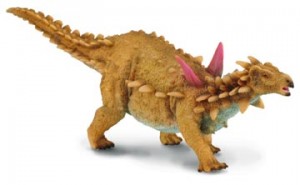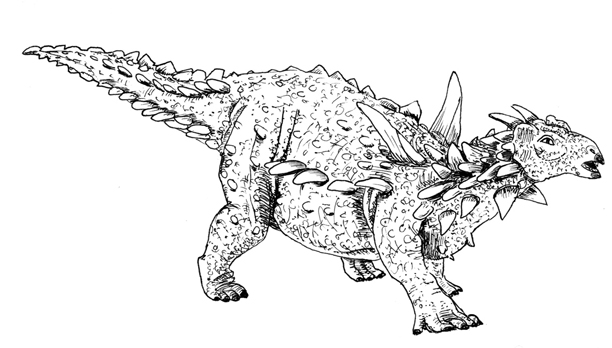Scelidosaurus – a uniquely British Dinosaur ready to go on Display
The most complete dinosaur skeleton ever found in the UK is about to go on display at Bristol museum. The dinosaur, identified as a Scelidosaurus was not found in the dinosaur rich sediments of the Isle of Wight, nor was it found in Oxfordshire, another likely place to find dinosaur fossils. Instead, this dinosaur was found on a beach in Dorset, an area much more associated with fossils of marine reptiles such as plesiosaurs and ichthyosaurs.
Scelidosaurus Fossils
The first pieces were found by professional fossil collector David Sole in 2000. His keen eye spotted something strange on the beach and decided to investigate further.
“There was a lump of rock about two foot by one foot lodged in fine-shingle sand, and I sensed there was something unusual about it,” he remembers.
Closer examination revealed that the chunk of rock was limestone and that it was packed with fossil bone. Over the next few months and years, further pieces were found in the area, all coming from what had been one individual dinosaur.
Fossilised Bone
The limestone surrounding the fossilised bone was carefully removed using a dilute acid preparation (acetic acid) which slowly dissolved away the surrounding rock to reveal the fossils within. The dinosaur was identified as a Scelidosaurus, an early bird-hipped (ornithischian) dinosaur, which lived in the Early Jurassic approximately 195 million years ago.
This acid soaking technique was pioneered by British scientists working at the Natural History museum – London, in the 1960s and first used to help remove the surrounding matrix from another fossil of Scelidosaurus found entombed in limestone (S. harrisoni). It was this fossil, another near complete specimen found in the late 1850’s that was described and named by Sir Richard Owen in 1863. At first the fossil was identified as a kind of crocodile, but further analysis proved that this was indeed a dinosaur but one that had been found in marine sediments.
“It has heavy spines all over its body, with two goat-like horns on the back of the skull forming a kind of ruff with its neck armour. This leads to the inference that this specimen was likely to have been a mature male,” explains Dr Tim Ewin of Bristol City Museum and Art Gallery, where this early plant-eating dinosaur will go on display to the public in June.
Up until this particular discovery only a handful of scelidosaur remains had been discovered, all from an outcrop of rock in the Lyme Regis/Charmouth area of Dorset, so all the remains of this armoured dinosaur seem to have been found in rocks that were laid down at the bottom of a shallow sea. It is rather odd to find such an animal amongst strata more commonly associated with ammonites and belemnites, especially as scientists have never found any evidence that dinosaurs took to a marine existence. How did the fossils of these dinosaurs end up in these sediments?
The answer may lie in the ancient Early Jurassic landscape that made up what was to become the British Isles. During this period, the land in the area that was eventually to become the location of the southern part of the UK, consisted of a series of small, low-lying, tropical islands that were surrounded by a warm, shallow sea. The area resembled the Caribbean of today. Scelidosaurus could have been endemic to just a few islands, perhaps with each island having its own sub-species (this may help explain some of the different features that have been seen in the different specimens found).
Alternatively, this fossils found to date could be the remains of a small herd, with animals at various ages of maturity within it, this would also explain some of the subtle differences between the fossilised skeletons.
A model of a Scelidosaurus
Picture credit: Everything Dinosaur
An Armoured Dinosaur
Scelidosaurus was an early armoured dinosaur, with an estimated maximum length of around 4 metres. It was quite a heavy-set dinosaur with bony plates and bumps providing armour-like protection for the back and flanks. Another specimen of Scelidosaurus has traces of a skin impression, this reveals that the skin had a bumpy texture, being made up of a mosaic of small, rounded scales.
An Illustration of Scelidosaurus harrisoni
Picture credit: Everything Dinosaur
The picture of Scelidosaurus was taken from the Everything Dinosaur party model collection of dinosaurs. Unfortunately, there are very few models of this dinosaur about, perhaps the most famous model was the black Scelidosaurus that was produced by the Invicta company in the 1960s. This series which was for such a long time the mainstay of the Natural History museum’s model collection has been out of production for some years. The little Scelidosaurus model (priced at 27 pence when one of our team members bought it in the mid 1970s), can still be seen in one of the Natural History museum’s dinosaur displays. The Invicta models are highly prized by model collectors, we think the Scelidosaurus model would be worth a lot more than 27p today.
Scelidosaurus
To view range of dinosaur models available at Everything Dinosaur: Dinosaur Toys and Models.
Unusually, the specimen first found by David Sole, is an almost-complete skeleton. The fossil bones are articulated, meaning that each bone was linked and in its correct place. Equally striking were the long, thin tendons that supported the animal’s huge stomach, which still stretched from the backbone – and the fact that the creature’s gullet contained a discoloured area, with the remains of its last meal.
Commenting on this particular find, a researcher stated: “It could be that Scelidosaurus only lived on one island, a few miles away from Lyme Regis, which would explain why the species has not been reported anywhere else. We began to wonder if we were looking at a family group that was washed off the island by a sudden tsunami, similar to what we saw on Boxing Day 2004.”
Found in Marine Sediments
Alternatively, the reason why scelidosaurs have been found in marine sediments, with many of the fossils in an upside-down orientation could be because these animals were washed out to sea and then slowly sank to the bottom. If scelidosaurs lived well inland, perhaps in upland areas that were drained by rivers, flash floods could occur drowning individual animals and transporting them down the valleys out to sea. During decay, the corpse would have become bloated and filled with gas, buoying up the body for some time. The animal would have floated on its back, with the heavy armour acting like a keel on a ship. Eventually, the body cavity would have ruptured , the gases escaped and the corpse would sink, settling on the seabed with the belly upwards.
However, these animals came to be found in Dorset remains a bit of a mystery. A dark patch where the gullet would have been perhaps indicates that this particular animal vomited, this is often seen in animals that are drowning, so maybe this animal was swept out to sea from an island that was hit by a tidal wave. Interestingly, crocodile teeth have been found in the mouth of this fossil, not evidence of predation but more likely regurgitated up items from the gizzard as this plant-eater may have swallowed hard objects to help it grind up and digest tough plant material. Certainly, a low-lying island would have few stones suitable for swallowing (assuming a sandy beach), crocodiles shed their teeth regularly and these would have helped with the digestion process once swallowed and provide plenty of calcium to help form the bony armour.
It seems that the fossils of Scelidosaurus can be interpreted in many different ways, perhaps they were upland animals, washed out to sea in a flash flood, or maybe they lived on small islands that were swamped by a tsunami, evidence can be put forward to support each theory.
Ironically, had it not been for the storms that occasionally batter the south coast of England these fossils would never have been eroded out of the rocks allowing them to be found and studied in the first place.
Scelidosaurus Dinosaur Model
The dinosaur model shown in this article is from the CollectA Deluxe Age of Dinosaurs model range, to view this range of scale model prehistoric animals: CollectA Deluxe Prehistoric Life Models.








Leave A Comment